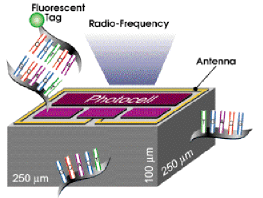
Laser-Powered Chips Sample DNA
Hank Hogan
A technology using light-activated microtransponders to achieve inexpensive, high-throughput immunoassays or DNA probe assays is under development at PharmaSeq Inc. Promising flow cytometry rates, the technique may be able to test for 10,000 DNA sequences in minutes.
The 250 × 250 × 100-µm microtransponders comprise an array of photovoltaic cells, the memory to store an identification number, and an antenna and circuitry developed by Sarnoff Corp. of Princeton, N.J., to transmit that number over a low-megahertz radio link. The manufacturing techniques and associated costs are similar to those used to produce semiconductor chips.
 The first step in using a microtransponder as a DNA probe begins after the device is fabricated. Using a proprietary process, PharmaSeq attaches oligonucleotide probes to the silicon dioxide or silicon nitride coating on the microchip. Each chip has thousands of the probes, and different chips have different types of probes.
The first step in using a microtransponder as a DNA probe begins after the device is fabricated. Using a proprietary process, PharmaSeq attaches oligonucleotide probes to the silicon dioxide or silicon nitride coating on the microchip. Each chip has thousands of the probes, and different chips have different types of probes.
The user immerses the transponders in a solution containing a fluorescein-tagged specimen to be tested. As the mixture flows through a capillary tube and past a laser beam, the light powers the chips to broadcast their identification numbers and causes any fluorescein-labeled sequences that they have collected to glow. A scanner detects and matches the flashes to the signals, enabling the user to identify the fluorescing nucleic acid by the corresponding oligonucleotide probe on the responding chip.
PharmaSeq has built functioning microtransponders and has tested the technology using simulators. Once its research and development are completed, the company plans to manufacture and license the technique.
Published: September 2000